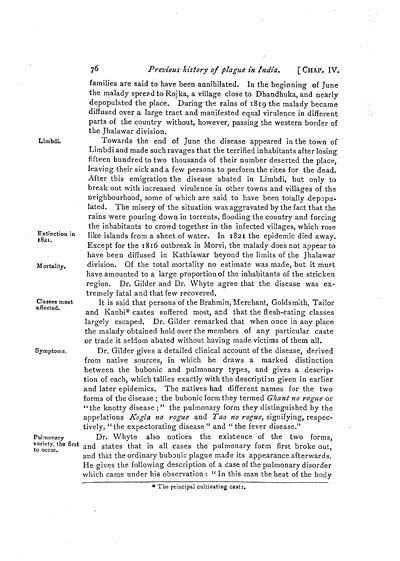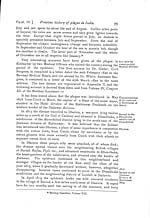Medicine - Disease > Plague in India, 1896, 1897 > Volume 1
(97) Page 76
Download files
Individual page:
Thumbnail gallery: Grid view | List view

76 Previous history of plague in India. [ CHAP. IV.
families are said to have been annihilated. In the beginning of June
the malady spread to Rojka, a village close to Dhandhuka, and nearly
depopulated the place. During the rains of 1819 the malady became
diffused over a large tract and manifested equal virulence in different
parts of the country without, however, passing the western border of
the Jhalawar division.
Limbdi.
Extinction in
1821.
Mortality.
Towards the end of June the disease appeared in the town of
Limbdi and made such ravages that the terrified inhabitants after losing
fifteen hundred to two thousands of their number deserted the place,
leaving their sick and a few persons to perform the rites for the dead.
After this emigration the disease abated in Limbdi, but only to
break out with increased virulence in other towns and villages of the
neighbourhood, some of which are said to have been totally depopu-
lated. The misery of the situation was aggravated by the fact that the
rains were pouring down in torrents, flooding the country and forcing
the inhabitants to crowd together in the infected villages, which rose
like islands from a sheet of water. In 1821 the epidemic died away.
Except for the 1816 outbreak in Morvi, the malady does not appear to
have been diffused in Kathiawar beyond the limits of the Jhalawar
division. Of the total mortality no estimate was made, but it must
have amounted to a large proportion of the inhabitants of the stricken
region. Dr. Gilder and Dr. Whyte agree that the disease was ex-
tremely fatal and that few recovered.
Classes most
affected.
It is said that persons of the Brahmin, Merchant, Goldsmith, Tailor
and Kanbi* castes suffered most, and that the flesh-eating classes
largely escaped. Dr. Gilder remarked that when once in any place
the malady obtained hold over the members of any particular caste
or trade it seldom abated without having made victims of them all.
Symptoms.
Dr. Gilder gives a detailed clinical account of the disease, derived
from native sources, in which he draws a marked distinction
between the bubonic and pulmonary types, and gives a descrip-
tion of each, which tallies exactly with the description given in earlier
and later epidemics. The natives had different names for the two
forms of the disease; the bubonic form they termed Ghant no rogue or
"the knotty disease; " the pulmonary form they distinguished by the
appelations Kogla no rogue and Tao no rogue, signifying, respec-
tively, "the expectorating disease" and "the fever disease."
Pulmonary
variety, the first
to occur.
Dr. Whyte also notices the existence of the two forms,
and states that in all cases the pulmonary form first broke out,
and that the ordinary bubonic plague made its appearance afterwards.
He gives the following description of a case of the pulmonary disorder
which came under his observation: " In this man the heat of the body
* The principal cultivating caste.
families are said to have been annihilated. In the beginning of June
the malady spread to Rojka, a village close to Dhandhuka, and nearly
depopulated the place. During the rains of 1819 the malady became
diffused over a large tract and manifested equal virulence in different
parts of the country without, however, passing the western border of
the Jhalawar division.
Limbdi.
Extinction in
1821.
Mortality.
Towards the end of June the disease appeared in the town of
Limbdi and made such ravages that the terrified inhabitants after losing
fifteen hundred to two thousands of their number deserted the place,
leaving their sick and a few persons to perform the rites for the dead.
After this emigration the disease abated in Limbdi, but only to
break out with increased virulence in other towns and villages of the
neighbourhood, some of which are said to have been totally depopu-
lated. The misery of the situation was aggravated by the fact that the
rains were pouring down in torrents, flooding the country and forcing
the inhabitants to crowd together in the infected villages, which rose
like islands from a sheet of water. In 1821 the epidemic died away.
Except for the 1816 outbreak in Morvi, the malady does not appear to
have been diffused in Kathiawar beyond the limits of the Jhalawar
division. Of the total mortality no estimate was made, but it must
have amounted to a large proportion of the inhabitants of the stricken
region. Dr. Gilder and Dr. Whyte agree that the disease was ex-
tremely fatal and that few recovered.
Classes most
affected.
It is said that persons of the Brahmin, Merchant, Goldsmith, Tailor
and Kanbi* castes suffered most, and that the flesh-eating classes
largely escaped. Dr. Gilder remarked that when once in any place
the malady obtained hold over the members of any particular caste
or trade it seldom abated without having made victims of them all.
Symptoms.
Dr. Gilder gives a detailed clinical account of the disease, derived
from native sources, in which he draws a marked distinction
between the bubonic and pulmonary types, and gives a descrip-
tion of each, which tallies exactly with the description given in earlier
and later epidemics. The natives had different names for the two
forms of the disease; the bubonic form they termed Ghant no rogue or
"the knotty disease; " the pulmonary form they distinguished by the
appelations Kogla no rogue and Tao no rogue, signifying, respec-
tively, "the expectorating disease" and "the fever disease."
Pulmonary
variety, the first
to occur.
Dr. Whyte also notices the existence of the two forms,
and states that in all cases the pulmonary form first broke out,
and that the ordinary bubonic plague made its appearance afterwards.
He gives the following description of a case of the pulmonary disorder
which came under his observation: " In this man the heat of the body
* The principal cultivating caste.
Set display mode to: Large image | Zoom image | Transcription
Images and transcriptions on this page, including medium image downloads, may be used under the Creative Commons Attribution 4.0 International Licence unless otherwise stated. ![]()
| India Papers > Medicine - Disease > Plague in India, 1896, 1897 > Volume 1 > (97) Page 76 |
|---|
| Permanent URL | https://digital.nls.uk/74593886 |
|---|




